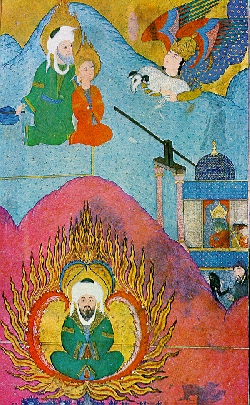Nimrod
Nimrod is a figure mentioned in the Book of Genesis of the Hebrew Bible and the Christian Old Testament, often associated with the construction of the Tower of Babel. According to Genesis 10:8-12, Nimrod was a mighty hunter before the Lord and the first powerful ruler on Earth. His kingdom initially included the cities of Babylon, Erech, Akkad, and Calneh, in the land of Shinar (Mesopotamia). The passage also suggests that he expanded his territory into Assyria, where he built Nineveh, Rehoboth-Ir, Calah, and Resen. The name Nimrod itself has become synonymous with a great hunter or warrior, and his story has been subject to various interpretations and embellishments over the centuries.
Biblical Account[edit | edit source]
The biblical account of Nimrod is brief, and much of what is known about him comes from interpretation and Jewish and Christian traditions. Genesis 10, part of the Table of Nations, describes him as a descendant of Noah's son Ham, through Cush. Nimrod's reputation as a mighty hunter is emphasized, and this characteristic is often interpreted symbolically to mean he was a powerful and tyrannical ruler. The phrase "mighty hunter before the Lord" suggests he might have been seen as a rebellious figure, challenging divine authority. His association with the Tower of Babel, although not explicitly mentioned in Genesis, comes from later Jewish tradition which identifies him as the leader who instigated its construction, leading to the confusion of languages by God as a punishment for human pride and disobedience.
Historical and Cultural Context[edit | edit source]
The historical and cultural context of Nimrod is deeply rooted in ancient Mesopotamian civilization. The cities mentioned as part of his kingdom are all significant urban centers of the time, suggesting his story may have a basis in the memories of real historical figures or events. Mesopotamia, often referred to as the cradle of civilization, was the site of many early developments in agriculture, writing, trade, and government. Nimrod's image as a ruler of these cities ties him to the early urban and imperial ambitions of this region.
Interpretations and Legacy[edit | edit source]
Over the centuries, Nimrod's character has been interpreted in various ways, reflecting the values and concerns of different cultures and periods. In Jewish tradition, he is often seen as a tyrant who led humanity away from God. In contrast, some Christian interpretations view him more favorably as a skilled hunter and powerful leader. The figure of Nimrod has also appeared in Islamic tradition and in the mythology and folklore of the Near East.
The legacy of Nimrod extends beyond religious texts into literature, art, and popular culture, where his image as a mighty hunter and ruler continues to resonate. His story has been used to explore themes of ambition, rebellion, and the relationship between humanity and the divine.
See Also[edit | edit source]
Search WikiMD
Ad.Tired of being Overweight? Try W8MD's physician weight loss program.
Semaglutide (Ozempic / Wegovy and Tirzepatide (Mounjaro / Zepbound) available.
Advertise on WikiMD
|
WikiMD's Wellness Encyclopedia |
| Let Food Be Thy Medicine Medicine Thy Food - Hippocrates |
Translate this page: - East Asian
中文,
日本,
한국어,
South Asian
हिन्दी,
தமிழ்,
తెలుగు,
Urdu,
ಕನ್ನಡ,
Southeast Asian
Indonesian,
Vietnamese,
Thai,
မြန်မာဘာသာ,
বাংলা
European
español,
Deutsch,
français,
Greek,
português do Brasil,
polski,
română,
русский,
Nederlands,
norsk,
svenska,
suomi,
Italian
Middle Eastern & African
عربى,
Turkish,
Persian,
Hebrew,
Afrikaans,
isiZulu,
Kiswahili,
Other
Bulgarian,
Hungarian,
Czech,
Swedish,
മലയാളം,
मराठी,
ਪੰਜਾਬੀ,
ગુજરાતી,
Portuguese,
Ukrainian
Medical Disclaimer: WikiMD is not a substitute for professional medical advice. The information on WikiMD is provided as an information resource only, may be incorrect, outdated or misleading, and is not to be used or relied on for any diagnostic or treatment purposes. Please consult your health care provider before making any healthcare decisions or for guidance about a specific medical condition. WikiMD expressly disclaims responsibility, and shall have no liability, for any damages, loss, injury, or liability whatsoever suffered as a result of your reliance on the information contained in this site. By visiting this site you agree to the foregoing terms and conditions, which may from time to time be changed or supplemented by WikiMD. If you do not agree to the foregoing terms and conditions, you should not enter or use this site. See full disclaimer.
Credits:Most images are courtesy of Wikimedia commons, and templates Wikipedia, licensed under CC BY SA or similar.
Contributors: Prab R. Tumpati, MD



